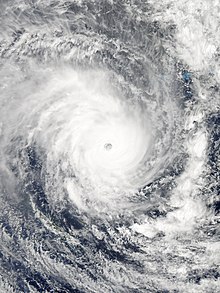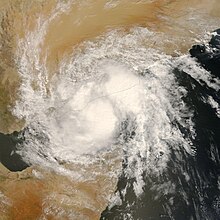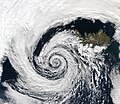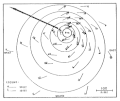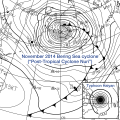Portal:Tropical cyclones
The Tropical Cyclones Portal
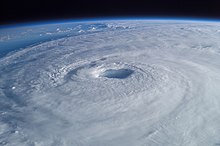
A tropical cyclone is a storm system characterized by a large low-pressure center, a closed low-level circulation and a spiral arrangement of numerous thunderstorms that produce strong winds and heavy rainfall. Tropical cyclones feed on the heat released when moist air rises, resulting in condensation of water vapor contained in the moist air. They are fueled by a different heat mechanism than other cyclonic windstorms such as Nor'easters, European windstorms and polar lows, leading to their classification as "warm core" storm systems. Most tropical cyclones originate in the doldrums, approximately ten degrees from the Equator.
The term "tropical" refers to both the geographic origin of these systems, which form almost exclusively in tropical regions of the globe, as well as to their formation in maritime tropical air masses. The term "cyclone" refers to such storms' cyclonic nature, with anticlockwise rotation in the Northern Hemisphere and clockwise rotation in the Southern Hemisphere. Depending on its location and intensity, a tropical cyclone may be referred to by names such as "hurricane", "typhoon", "tropical storm", "cyclonic storm", "tropical depression" or simply "cyclone".
Types of cyclone: 1. A "Typhoon" is a tropical cyclone located in the North-west Pacific Ocean which has the most cyclonic activity and storms occur year-round. 2. A "Hurricane" is also a tropical cyclone located at the North Atlantic Ocean or North-east Pacific Ocean which have an average storm activity and storms typically form between May 15 and November 30. 3. A "Cyclone" is a tropical cyclone that occurs in the South Pacific and Indian Oceans.
Selected named cyclone -
Severe Tropical Cyclone Pam was the second most intense tropical cyclone of the South Pacific Ocean in terms of sustained winds and is regarded as one of the worst natural disasters in the history of Vanuatu. A total of 15–16 people died either directly or indirectly as a result of Pam with many others injured. The storm's impacts were also felt, albeit to a lesser extent, on other islands in the South Pacific, most notably the Solomon Islands, Tuvalu, and New Zealand. Pam is the third most intense storm of the South Pacific Ocean according to pressure, after Winston of 2016 and Zoe of 2002. It is also the second most intense tropical cyclone in 2015, only behind Hurricane Patricia. In addition, Pam is tied with Orson, Monica, Marcus and Fantala for having the second strongest ten-minute maximum sustained winds in the Southern Hemisphere. Thousands of homes, schools and buildings were damaged or destroyed, with an estimated 3,300 people displaced as a result.
Pam formed on 6 March, east of the Solomon Islands and tracked slowly in a generally southward direction, slowly intensifying as it did so. Two days later, the disturbance reached tropical cyclone intensity and, over subsequent days, Pam gradually strengthened before reaching Category 5 cyclone status on both the Australian and Saffir–Simpson scales on 12 March. The next day, Pam's sustained winds peaked at 250 km/h (155 mph) as the storm moved through Vanuatu, passing near several constituent islands and making direct hits on others. On 14 March, Pam's winds began to slowly weaken, but its pressure dropped further to a minimum of 896 mbar (hPa; 26.46 inHg) before rising shortly afterwards. Over the next few days, the cyclone's weakening accelerated as it moved poleward. On 15 March, Pam passed northeast of New Zealand before transitioning into an extratropical cyclone that same day. (Full article...)
Selected article -
Deep Depression ARB 02 was a weak yet costly tropical cyclone which caused extensive damage and loss of life in Yemen. The sixth tropical cyclone and third deep depression of the 2008 North Indian Ocean cyclone season, ARB 02 formed in the Arabian Sea on October 19 from the same broader system which would spawn Moderate Tropical Storm Asma in the southern Indian Ocean around that time. Moving generally westward, the depression failed to intensify further, reaching maximum sustained winds of 55 km/h (35 mph). It would weaken, becoming a remnant low on October 23. Later that day, the system's remnants would make landfall near Ash Shihr in eastern Yemen.
The storm sent a plume of moisture throughout the Arabian Peninsula, contributing to dust storms as far north as Iraq. However, the effects were most severe in Yemen, becoming the second-worst natural disaster in the country after deadly floods in 1996. The storm dropped heavy rainfall in a normally arid region, reaching around 91 mm (3.6 in), which caused flash flooding in valleys after waterways were unable to contain the approximately 2 billion km3 (528 billion gallons) of water that fell. Poor drainage practices and an invasive species of weed contributed to the floods, which damaged or destroyed 6,505 houses, leaving about 25,000 people homeless. The floods killed 180 people and severely disrupted the livelihoods of about 700,000 residents of Hadhramaut and Al Mahrah governorates, mostly farmers whose fields were washed away. Some of the buildings at the Shibam UNESCO World Heritage Site collapsed due to the floods. Overall damage was estimated at US$874.8 million, although residual losses from damaged infrastructure were estimated to cost an additional US$726.9 million. The overall economic impact of the storm was therefore estimated at US$1.638 billion, equating to roughly 6% of the country's gross domestic product. (Full article...)
Selected image -

Selected season -

The 1997 Pacific hurricane season was a very active hurricane season. With hundreds of deaths and hundreds of millions of dollars in damage, this was one of the deadliest and costliest Pacific hurricane seasons on record. This was due to the exceptionally strong 1997–98 El Niño event. The season officially started on May 15, in the eastern Pacific, and on June 1, in the central Pacific, and lasted until November 30. These dates conventionally delimit the period of each year when almost all tropical cyclones form in the northeastern Pacific Ocean.
Several storms impacted land. The first was Tropical Storm Andres which killed four people and left another two missing. In August, Tropical Storm Ignacio took an unusual path through the basin, resulting in its extratropical remnants causing minimal damage throughout the Pacific Northwest and California. Linda became the most intense east Pacific hurricane in recorded history, a record it maintained until it was surpassed by Hurricane Patricia in 2015. Although it never made landfall, it produced large surf in Southern California and as a result, five people had to be rescued. Hurricane Nora caused flooding and damage in the Southwestern United States, while Olaf made two landfalls and caused eighteen deaths and several other people were reported missing. Hurricane Pauline killed several hundred people and caused record damage in southeastern Mexico. In addition, Super Typhoons Oliwa and Paka originated in the region before crossing the International Date Line and causing significant damage in the western Pacific. There were also two Category 5 hurricanes: Linda and Guillermo. (Full article...)
Related portals
Currently active tropical cyclones

Italicized basins are unofficial.
- West Pacific (2024)
- No active systems
- North Indian Ocean (2024)
- No active systems
- Mediterranean (2024–25)
- No active systems
- South-West Indian Ocean (2024–25)
- No active systems
- Australian region (2024–25)
- No active systems
- South Pacific (2024–25)
- No active systems
- South Atlantic (2024–25)
- No active systems
Last updated: 09:15, 2 November 2024 (UTC)
Tropical cyclone anniversaries

November 2
- 1997 - Tropical Storm Linda (pictured) made landfall on southern Vietnam and later moved across the Malay Peninsula, killing 3,123 people.

November 3
- 1989 - Typhoon Gay (pictured) made the strongest ever-recorded landfall in Thailand, killing a total of 1,036 people.
- 2015 - Cyclone Chapala became the strongest tropical cyclone on record to strike Yemen.
- 2020 - Hurricane Eta made landfall in Nicaragua as a Category 4 hurricane, killing 211 people and causing damages of over US$7.9 billion.

November 4
- 1984 - Typhoon Agnes makes landfall over in Visayas, Philippines as a Category 4, killing 1,029 people along with damage losses of $90.7 million.
- 2001 - Hurricane Michelle (pictured) made landfall on western Cuba as a Category 4 hurricane causing about $1.8 billion of damage throughout the country.
Did you know…
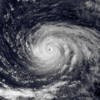



- …that the Joint Typhoon Warning Center considers that Typhoon Vera (pictured) of 1986 is actually two distinct systems, formed from two separated low-level circulations?
- …that Cyclone Freddy (track pictured) in 2023 was the longest-lasting tropical cyclone worldwide?
- …that Cyclone Raquel (track pictured) travelled between the Australian and South Pacific basins between the 2014–15 and 2015–16 seasons, spanning both seasons in both basins?
- …that Hurricane Otis (pictured) in 2023 was the first Pacific hurricane to make landfall at Category 5 intensity and surpassed Hurricane Patricia as the strongest landfalling Pacific hurricane on record?
General images -

The 2010 Pacific hurricane season was one of the least active seasons on record, featuring the fewest named storms since 1977. The season officially started on May 15 in the eastern Pacific—east of 140°W—and on June 1 in the central Pacific—between the International Date Line and 140°W—and lasted until November 30. These dates typically cover the period of each year when most tropical cyclones form in the eastern Pacific basin. The season's first storm, Tropical Storm Agatha, developed on May 29; the season's final storm, Tropical Storm Omeka, degenerated on December 21.
The season began with record-breaking activity with four named storms, including two major hurricanes, developing by the end of June. Accumulated cyclone energy (ACE) values exceeded 300 percent of the average for the month of June. Activity abruptly diminished thereafter, with July, August, and September seeing record low storm development. The Eastern Pacific season proper ended with Tropical Storm Georgette's dissipation on September 23, a month before the climatological mean. The year's final cyclone, Omeka, developed in the off-season on December 18, marking a record-late formation date in the satellite-era. Although there were relatively few storms, the season proved exceptionally deadly and destructive. Torrential rains associated with Agatha and Eleven-E killed well over 200 people in Central America and Mexico and left more than $1.5 billion in damage. (Full article...)
Topics
Subcategories
Related WikiProjects
WikiProject Tropical cyclones is the central point of coordination for Wikipedia's coverage of tropical cyclones. Feel free to help!
WikiProject Weather is the main center point of coordination for Wikipedia's coverage of meteorology in general, and the parent project of WikiProject Tropical cyclones. Three other branches of WikiProject Weather in particular share significant overlaps with WikiProject Tropical cyclones:
- The Non-tropical storms task force coordinates most of Wikipedia's coverage on extratropical cyclones, which tropical cyclones often transition into near the end of their lifespan.
- The Floods task force takes on the scope of flooding events all over the world, with rainfall from tropical cyclones a significant factor in many of them.
- WikiProject Severe weather documents the effects of extreme weather such as tornadoes, which landfalling tropical cyclones can produce.
Things you can do
 |
Here are some tasks awaiting attention:
|
Wikimedia
The following Wikimedia Foundation sister projects provide more on this subject:
-
Commons
Free media repository -
Wikibooks
Free textbooks and manuals -
Wikidata
Free knowledge base -
Wikinews
Free-content news -
Wikiquote
Collection of quotations -
Wikisource
Free-content library -
Wikiversity
Free learning tools -
Wikivoyage
Free travel guide -
Wiktionary
Dictionary and thesaurus

